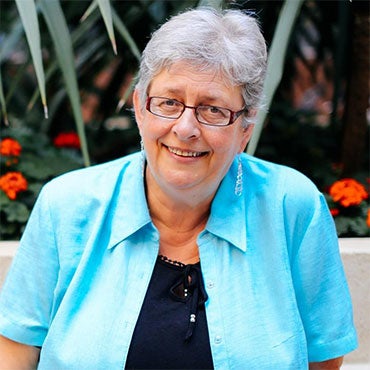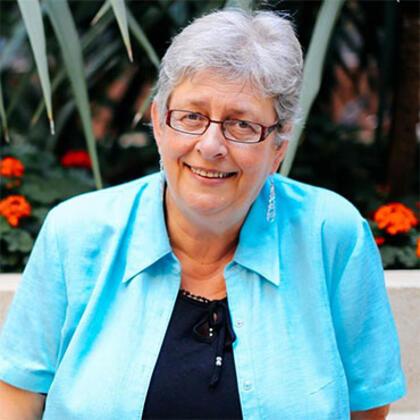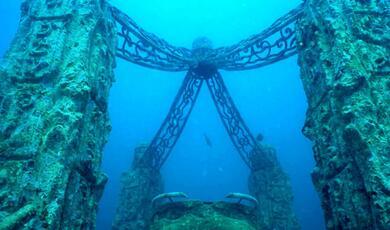Professionally 'Green': Environmental Challenges and UK Professional Bodies
Share
- Details
- Transcript
- Audio
- Downloads
- Extra Reading
Many of the UK's professional bodies have an explicit or implicit environmental remit (such as the 'Chartered Institute of Environmental Management & Assessment') but others, less clearly associated with environmental matters, also address these issues.
The role of professional bodies will be discussed, focusing on the tackling of real and urgent environmental challenges.
Download Transcript
12 February 2015
Professionally ‘Green’: Environmental Challenges and UK Professional Bodies
Professor Carolyn Roberts
I want to talk to you tonight about the activities of some of the national organisations that are involved in activity intended to benefit the state of our environment, in the UK and internationally. I am going to focus in particular on the UK’s professional bodies, many of which have an explicit or implicit environmental remit (for example the ‘Institute of Environmental Management & Assessment’, the ‘Institute of Fisheries Management’, and the ‘Institution of Environmental Sciences’) while others, less directly associated with environmental matters, also address such concerns in relation to the built environment. These would include the Institution of Civil Engineers, and the Royal Town Planning Institute, for example. Some of these groups are very large indeed, and a conservative estimate of their total membership, (ignoring dual registrations) would be well in excess of half a million people. Most of these people are based in the UK, but some of the organisations have international memberships, though usually a minority. For comparison, the diagram shows the membership of the main UK political parties, which in total do not come close. It is also worth reflecting that a 2010 analysis suggested about 900,000 ‘green’ jobs in the UK, and growing.
This size should be a good thing, a reflection of the fact that there is wide public and professional interest in addressing environmental challenges in a proactive and effective way, and power to do so amongst the community, but I shall argue tonight that in the face of these pressing concerns, the current situation is unhelpful. Whilst the actions of every single group are entirely laudable, overlapping and competing interests are not conducive either to the establishment of a clear position based on the best possible scientific, technical and other evidence, nor to the presentation of a unified voice to government or industry. Indeed, some might go further and argue that these organisations are miniature fiefdoms, primarily serving the interests of their members and secretariats rather than benefiting the environment, a position which would horrify many of their members. In order to explore this tension, the role of professional bodies in two specific environmental controversies will be discussed – the Somerset Levels flooding of 2013-14, and the current debate on fracking.
As an aside, and lest we think that public interest in environmental themes is collapsing, a poll by ComRes this week showed that an average of 28% of British adults would totally switch their political allegiances in May 2015’s national election if their party of choice abandoned their commitments to tackling climate change. The poll was commissioned by a consortium of voluntary bodies including Oxfam and some of the UK’s other largest charities. Surprisingly perhaps, 77% of young (18-24 year old) Conservative voters indicated that they were very or fairly concerned about climate change, and could vote in a different way, though the figures were lower for older Conservative voters. The figures for potential Labour and Liberal Democrat voters suggest that their level of concern is generally higher, and moreover 58% of the 2000 people polled said that they wanted to hear the leader of their chosen party make a strong commitment to climate targets. Food for thought, even if statements in polls are not entirely accurate depictions of subsequent action. The poll also mirrors my own analysis of the views of some eighty people working in various environmentally-related professions, as expressed in structured interviews. A Wordle here summarises their thoughts on critical issues for the UK, drawing out the overwhelming importance of climate change in their thinking, but also reflecting strong interest in water-related challenges. However, I don’t hold this to be a representative sample.
I want to start by reviewing how a range of UK professional bodies responded to the flooding of the Somerset levels in winter 2013-14, before drawing out some conclusions. We will all probably recall the sort of imagery associated with this event – the initial stoicism of villagers, followed by increasingly stressed protests as the waters rose inexorably, the moving sight of desperate farmers moving livestock with assistance provided from across the country, the deployment of the military, senior politicians in very new wellington boots visiting, and an almighty argument amongst a range of specialists about what should and could be done about the situation, if anything, when the waters had receded. This is a situation that has played out across the UK several times over the last few years, although with some added complexities arising from the local geography.
The background to the weather conditions are shown in the diagrams. Basically, following a wet autumn, much of the south of England received in excess of 200% of average rainfall in January. 200% of the monthly average is not so unusual for a period of a month, but it was combined with storminess, and high tides. River flows were exceptionally high, as were groundwater levels, again as shown in the images. Many of you will know that the Somerset Levels are an artificial human construct, land reclaimed in the last few centuries from being peaty wetland some only 3 or 4 meters above mean sea level (hence below high tide level), with periodic inundation from either sea or rivers. Historically, settlements were located on knolls of higher ground. In the summer months, dry grazing or crop land is traditionally achieved though a complex set of management arrangements which traditionally also maintained biodiversity. Field drainage, pumping of groundwater and surface water from drainage ditches up into rivers, tidal sluices, dredging and straightening the artificial channels, and embankments alongside major channels, have been used. In the winter of 2013-14, however, these measures were insufficient to keep up with the water arriving at the lowest points in the landscape from the higher moorland around, and about 600 houses and 7,000 hectares of land were inundated. Moreover, there were allegations that what is described as routine ‘maintenance’ of the channels of the Parrett and Tone rivers, had been neglected, and that sedimentation on banks and beds had reduced their capacity to accommodate high flows. A prosecution of two men for interfering with sluice gates near Thorny village, allegedly to protect their personal property is ongoing; deliberate human action may well have played a role in enhancing the flood levels locally. Counter-allegations were also made, that more houses had been permitted by local authorities or the Secretary of State to be built on the floodplains, a position that appears to be confirmed for the Sedgemoor area by mapping done for the Committee on Climate Change. In other words, it was alleged that local residents had effectively brought this situation upon themselves, at least in part, by choosing to live, in increasing numbers, on the Levels.
As the waters rose, various Government Ministers sympathized with local residents, but argued with each other rather acrimoniously, whilst a series of experts, mainly from universities and engineering companies, offered opinions on solutions to the flooding. The cacophony of voices was pretty overwhelming, instigated largely by TV and newspapers. The solutions that were suggested included many possibilities, from structural measures such as further deepening and dredging of the Levels, channel realignment and tidal gates, to catchment management approaches concerned with holding back or reducing the water flow from the surrounding intensive agricultural areas, charity payments or the payment of compensation to affected residents, and the ‘do nothing’ options. This latter was never going to be popular with local residents, or indeed the wider British public who were moved by the filming showing these grim conditions. This, of course, is a typical ‘wicked problem’, whose characteristics I have mentioned before…disputed language, complex problems involving human and physical dimensions, spatial and temporal interactions at different scales, lack of agreement on the nature of the problem and the solution, and general intractability. The solution to wicked problems lies in structured dialogue and it is perhaps too soon to see whether the Somerset Levels is being approached in a rational way. The immediate intervention was dredging.
Now, what of the professional bodies? Professional bodies, and I will review in a minute how these work and their detailed functions, theoretically offer the possibility of cutting through the complexities, and orchestrating a coherent and informed response to such situations, so that government can be measured in its approach. Professional bodies are made up of experts, in large numbers, as we have seen. Is this what happened? This next section reflects my personal views, based on my own role at the time as Chair of one of the umbrella organisations. You should be aware that the situation also generated, and continues to generate, a large amount of heat, but little light, amongst those who became embroiled.
As the drama unfolded, and experts began to appear on the TV screens, some of the professional bodies began to try to make group responses to government, but others did not. The Landscape Institute was one of those bodies concerned to try to bring different groups together, in late January 2014, by writing an open letter asking for action to be based on evidence, not mere assertion. It was signed by representatives from fifteen of the professional bodies, and widely reported in the media. Sue Illman, President at the time, also spoke in the media about the need for a multifaceted approach that was aligned with Government’s own policy in the Flooding and Water Act 2010, and the Natural Environment White Paper, and was roundly criticized by representatives from other groups. The umbrella organization, Society for the Environment also tried to coordinate, but only succeeded in securing support from half of its twenty three constituent environmental professional bodies, and the CEO felt unable to progress it. In some cases there was overt hostility to notions of collaboration, and in other cases environmental professional body representatives said that they were not explicitly concerned about flooding, and did not want to join the debate. Several said they were too small and under-resourced to consider responding. Concern was expressed by others that some potential solutions would disadvantage the economic position of their own members – those involved in dredging, for example, which was the most immediate visible and obvious response to the Somerset problem, but which other groups had suggested was ineffective. Other professional bodies evidently made separate and individual responses to government, only revealing their activity to fellow organisations afterwards. Several went on in subsequent months to produce their own analyses and suggestions about responses, but some time after the event, after the situation had died down a little in public consciousness.
Given this communication chaos, it is hardly to be expected that Government would hear the balance of professional opinion clearly, and presumably they listened mainly to those with the loudest voices and the best links. This is not a situation in which one could be at all confident in the proper engagement of stakeholders in decision making, characteristics of which should include inclusivity, transparency, learning, efficiency, efficacy and legitimacy, as Davies and colleagues express them (2003).
I want now to look at professional bodies, and similar organisations, in a little more detail, and to reflect on what might be done to improve the situation. Professional bodies are one set of a number of ill-defined groupings who want to influence decisions on, and action in some way for, the environment. The wider group includes NGOs, voluntary bodies and charities, trade associations, learned societies, livery companies, and some government departments and agencies. I am going to ignore the latter group, tonight.
The first group, the national environmental charities and voluntary bodies are in some ways the most interesting and diverse, and there are certainly hundreds operating in the UK at national level, and possibly thousands at local level. My slides show some of them – big names and much smaller ones too; many others will be missing, I know. Everyone will have their favorites; I particularly like the Tortoise Trust. Some are very radical, for instance Earth First! and the Deep Green Resistance movement, both of which propose direct action, if not social revolution, against developments and individuals of various sorts, and loosely coordinate local groups on specific engagements.
I leave you to judge where most UK Professional Bodies are in comparison with this spectrum from congeniality to revolution, but if we review them, they have a number of purposes. The CEO of the Institution of Environmental Sciences has described his organization as having five main purposes, namely knowledge sharing, networking individuals, representing the sector externally, acting as an umbrella for smaller groups, and maintaining professional standards. The emphasis or balance of the different activities varies from one professional body to another of course. Here is another speaker, with a different emphasis. Most are very concerned to ensure high standards of professional practice, although very few operate a ‘license to practice’. There are at least forty different environmentally-related professional bodies, illustrated I the slide.
Superimposed onto those, we have Learned Societies, often longstanding with royal patronage and a stronger emphasis on research, publications and conferences. We have some 21 or more London Livery companies with environmental interests and good connections into the City, and with similar remits but with a stringer social element. The Water Conservators are perhaps the most strongly environmentally focused. And we have Trade Associations, whose function is principally as groups of businesses, rather than individuals, but again where there are many, perhaps, hundreds, with environmental interests.
This plethora of organisations, in overlapping sets with intersecting interests is shown in my Venn diagram. I am sure everyone is familiar with a three set Venn diagram; this one is for five sets, and is an elegant way of positioning the types of activity that these groups typically do. We see, for example, that only a couple of categories normally offer Chartered status to members - the quality mark scheme for professionals. And only a couple (the Charities and the Livery) directly undertake charitable giving or other activity in the community, although others are charities for legal and tax purposes. Most of them do or commission some form of research, perhaps to a lesser extent the Livery or Trade Associations. But all of them attempt to influence government, and raise public awareness.
A range of CEOs of Professional Bodies very kindly agreed to speak about their own institutions, and I offer you just three examples – the Institute of Environmental management and Assessment, the Chartered Institution of Water and Environmental Management, and the Chartered Institution of Ecology and Environmental Management. As you will hear, they have their own distinct organizational ambitions, each with appeal, strong allegiances from members, and offering every reason for support. They ‘socialise’ their members ably, broker Continuing Professional Development (although sometimes by drawing on other organisations if they are themselves too small) and promote themselves to the public.
If we move to the level of specific disciplines, seeking to simplify there through focus, we again end up with complexity. As the background to this, I am using a diagram utilized until late last year by the Quality Assurance Agency in characterizing environmental courses in universities. Here we see another Venn diagram, but this time positioning different subjects, one against another, from geology to renewable energy studies, from engineering to environmental health (perhaps not such a long pathway), and from planetary science to development studies. Just to illustrate the scope of three Professional Bodies, this would be roughly the focus and range of the Institute of Fisheries Management, the second the equivalent for the Institution of Civil Engineers and this last the Landscape Institute. Again we find a confusing picture of overlap, duplication, and effectively some competition from forty Professional Bodies.
When this situation has arisen in other professions in the past, there have been changes in organisations through mergers and evolution, and indeed takeovers, that have tended to reduce the complexity, but this has not happened in the environmental sector, for whatever reason. I offer as an example, a diagram of the byzantine history of the Institution of Engineering Technology, whose changes from the nineteenth century through to today could surely not have been achieved without a certain amount of anguish on the part of its predecessor organisations, but which have left it well placed to be authoritative today.
Summarising, environmental Professional Bodies have a complex balancing act to perform with three main functions, related to furthering the interests and competencies of individuals, promoting and protecting the interests of the profession or discipline generally, and safeguarding the public interest, or society at large. This latter is of particular significance for environmental domains, of course, to a greater extent than might be the case for, many other Professional Bodies. Whilst this is simple, I do not believe that there could be a more complex arrangement of effectively competing organisations, in any sector, anywhere in the world. They all aspire to generate environmental improvement. They overlap in their remits and legal structures, and in their academic foci. Some are niche or specialist, and some all embracing. They compete for money, for membership, for subscriptions, for audiences, for attention, for status, for influence, and in terms of their messages. They probably do not have the ear of Government, and this is not surprising. People other than me have described some of these organisations as little fiefdoms, unaccountable, and mainly supporting the interests of their staff and individual members, rather than acting in the interests of the wider environment. This may or may not be a fair assessment. I offer no opinion on that. But I want to ask if we think this is potentially effective arrangement for securing the ear of government and generating the best opinions on environmental interventions?
I am going to conclude by a brief reflection on the subject of fracking, which is an area where some of the Professional Bodies are expressing interest, and which has attracted debate at a number of levels on environmental grounds. Fracking as, as many of you will know, the process of extracting fossil gas from shale deposits, for use as a fuel. Unlike the gas fields under the North Sea, the gas is trapped in rocks with low permeability and limited fracturing. So these deposits have to be fractured by high pressure injection of water and chemical mixtures, which releases the gas. The gas is then captured, cleaned and fed into the grid.
The debate occasioned by this process has been heated, and controversy reigns over issues such as the moral hazard occasioned by development of a fossil fuel, even if less atmospheric carbon is emitted than from other fossil fuel sources such as coal; the environmental impact of transport to and from sites, and of drilling; the potential for damaging pollution by leakages of toxic waters; visual amenity impacts including light pollution from flaring gas; damage to wildlife; seismic problems; noise and dust. For some commentators, future energy security is an overarching priority, together with an opportunity to generate wealth from selling gas, and to reduce the cost of energy to UK residents and businesses. For others, the need to increase the speed of the move to a low carbon economy, in line with climate change targets, is supreme. Local residents in areas identified as having potential resources, whether or not currently protected by legislation on National Parks and similar, are also quick to voice opinion, and to date I am not aware that any local group has been positive.
This issue is surely one where all of the environmental Professional Bodies have a legitimate interest and should be able to add constructively to debate, through collaboration. There are umbrella bodies that could help to broker this. Society for the Environment is one, and has an explicit role in generating collaboration. However, I have not yet found a synopsis that explicitly draws together the views from more than one Professional Body despite the fact that the views of environmental professionals are overwhelmingly reflected in concern about climate change, and almost every Professional Body mentions this somewhere in their aims and objectives. Most Professional Bodies (not all) have drawn back from expressing an opinion altogether, in some cases despite vocal pressures from some of their members. Or they are unable to do so as they are too small to have sufficient time for an analysis. One or two of the larger Bodies have recently input opinion to the UK Environmental Audit Committee’s ‘Environmental Risks of Fracking’ Inquiry. The Institution of Civil Engineers for example, did so last month. ICE commented on the necessity of environmental safeguards, including through the planning and permitting system, and emphasised that EIA would be required for exploration, production and decommissioning phases. However, they explicitly noted that they would not comment on the implications for carbon emissions. I am sure they are not alone in fighting shy of expressing a comprehensive view, because alone, they are not well placed to do so, and they risk alienating some of their membership if they do. Perhaps this is another challenge that is just too wicked?
I am going to leave the last word with one of the Professional Bodies, whose CEO is talking about revolutionary change, and what sort of people might be well placed to lead such a change. Thank you.
© Professor Carolyn Roberts, 2015
This event was on Thu, 12 Feb 2015
Support Gresham
Gresham College has offered an outstanding education to the public free of charge for over 400 years. Today, Gresham plays an important role in fostering a love of learning and a greater understanding of ourselves and the world around us. Your donation will help to widen our reach and to broaden our audience, allowing more people to benefit from a high-quality education from some of the brightest minds.


 Login
Login











